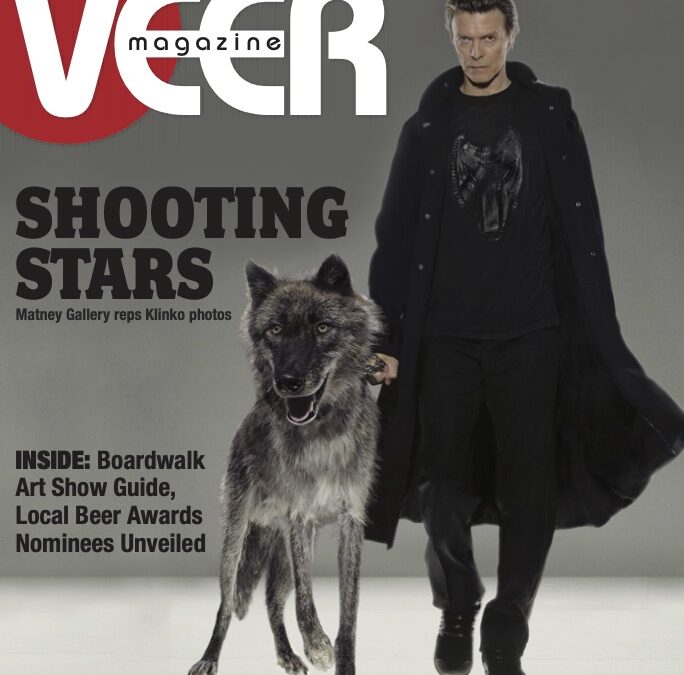By Jeff Maisey
Award-winning international celebrity/fashion photographer and director Markus Klinko is best known for capturing some of the most iconic images of the stars.
Klinko’s extensive portfolio includes captivating images Beyonce, Lady Gaga, David Bowie, Iman, Pharrell Williams, Mariah Carey, Britney Spears, Mary J. Blige, Jennifer Lopez, Joe Perry of Aerosmith, Anne Hathaway, Kim Kardashian, and Kanye West.
He’s also done photoshoots for such brands as Hugo Boss, Nike, L’Oréal Paris, Skyy Vodka, Lancôme, Pepsi, and Remy Martin.
Numerous art galleries around the world are authorized to represent and sell Klinko’s high-quality prints. Klinko’s work is highly sought after by serious art collectors both for the appreciation of having a Klinko on the wall at home or office, and for the purpose of art as an investment. Klinko’s photography is increasing in value.
The latest art dealer to rep Klinko is Williamsburg, Virginia-based Linda Matney Gallery. (NOTE: Photographs are available for purchase via Linda Matney Gallery)
In addition to representing Markus Klinko’s work, gallery owner John Lee Matney, in collaboration with Klinko, plans to work with a yet-to-be-determined art museum in the Norfolk/Virginia Beach/Williamsburg market for a proper exhibition of his photography.
I recently had a conversation by phone with Markus Klinko to discuss some of his popular images and his newfound connection with Linda Matney Gallery.
Here’s an excerpt from our discussion.
VEER: How did you and Lee Matney become connected?
MARKUS KLINKO (MK): My studio manager had been looking at galleries in that region of Virginia, and he got in touch with Lee and setup a call. So it is something relatively recent that the connection got made.
We really hit it off. He’s such an interesting, passionate curator, gallery owner, art lover, and artist himself. From the start it was really a very easy communication to start collaborating.
VEER: Lee Matney had mentioned that you were admired his photograph of Jeremy Ayers. As a photographer, what do you think of Matney’s work?
MK: I think his work is great. It is very spontaneous and very real.
That’s a style that’s quite different than my style, you know? My style is very staged and I would say Lee’s photography work feels so spontaneous. I looks like something a friend took while the person was just going about their life.
I think it’s interesting how photography has such a wide range and can reflect on the personality of the photographer…how the approach to photography can render the subject matter in such a different way.
VEER: The Linda Matney Gallery, which is named in honor of Lee’s late mother, is now representing your work. How many other galleries do you work with in this capacity? I was in Paris before the pandemic began and I saw your photos of David Bowie exhibited at a gallery there.
MK: Yes, I had a big show in Paris in 2016, so I assume you must have seen the one in St-Germain, maybe?
VEER: Yes, the gallery was on the Left Bank.
MK: Yeah, the Left Bank, exactly.
Unfortunately, that gallery closed during the pandemic.
To answer your question, I work with a lot of galleries around the world. It’s probably close to 50 at this point.
That includes, of course, Japan, Singapore, Hong Kong, Taiwan — as of this week; Australia, most European countries, and quite a few in the United States — west coast, east coast. Galleries in Texas. Several galleries in the New York area.
I like to be sort of omnipresent. That’s quite a goal of mine.
VEER: Is it more lucrative if you do a contracted, specific photoshoot for a fashion line or GQ magazine verses the sale of prints, which are matted and framed, at art galleries?
MK: Well, I don’t think it’s comparable. It is a completely different effort.
First of all, as an assignment photographer, which is what most of my nearly 30-year career was, I didn’t have the idea of galleries or museums in mind whatsoever. I was happy and excited to secure my assignments for magazines and, as you said, fashion brands.
For those types of assignments…the money really depends. It can go from almost nothing for a magazine shoot because editorial photo shoots don’t pay much at all. They’re more for exposure, like a storefront window of the photographer.
Other types of shoots can be very lucrative. I have shot fragrance campaigns and got paid hundreds of thousands of dollars in a single day. But I also have been able to sell a lot of work many, many years after the fact as limited edition fine art prints.
So I think maybe in 50 years my estate could probably best answer the question which was most lucrative.
I would say the art world…that’s as good as it gets. It’s unlimited in how far it could grow and how the demand could increase.
My goal and my dream is to really become the first recognized bluechip photographer.
In business, I am able to have separate dreams. One is an artistic dream and under that is a more business success type of dream.
I would like people to collect my work for two reasons. First, because they like it, and that’s what happens most of the time. They go to the gallery and love the subject matter; they love the photo, and they want to have it. They’re thinking less of resale and auction houses, and what’s that piece worth five years, ten years from now.
That’s great, but I also like the idea that somebody would invest and purchase a piece because they know and believe the price will not only double and triple, but go up tenfold, which has already happened for some of my work.
Some of my work literally started at under $4,000 not that long ago and is now priced at $50,000. Those are rare exceptions. Most of my work is not that expensive.
To go back to your question on which is more lucrative, one single print like that would pay more than what David Bowie paid me for an entire photoshoot, but the satisfaction and the pleasure of having done his photoshoot was of immense joy and brought immense other opportunities.
So you really have to look at it case by case. They’re all good. They’re part of who I am: doing the photoshoot, selling the photos; even licensing the photos.
You know I’ve done many photoshoots with celebrities like Beyonce, Mariah Carey, Mary J. Blige and people like that that were done for the (record) labels for album covers, but then brands like Pepsi, for instance, came along and wanted to license those photos for a Pepsi campaign.
In the case of Britany Spears, Elizabeth Arden came along and they wanted to do two outtakes of a photoshoot for a fragrance. So those were lucrative endeavors. And now Britany’s a big hit in my gallery repertoire.
It’s still very difficult to make money because it’s very expensive to be a photographer. It’s very expensive to print these prints. It’s traveling around the world and attending these openings. It’s not just all a cakewalk. It’s hard work and the competition is enormous.
When you look at those platforms like Artsy and ArtNet you can see literally tens of thousands of competitors. Collectors have a choice. If you want to buy a photo of David Bowie you have a choice. I’m not the only one, you know. There are many available works.
I’m always flattered when a collector chooses mine.
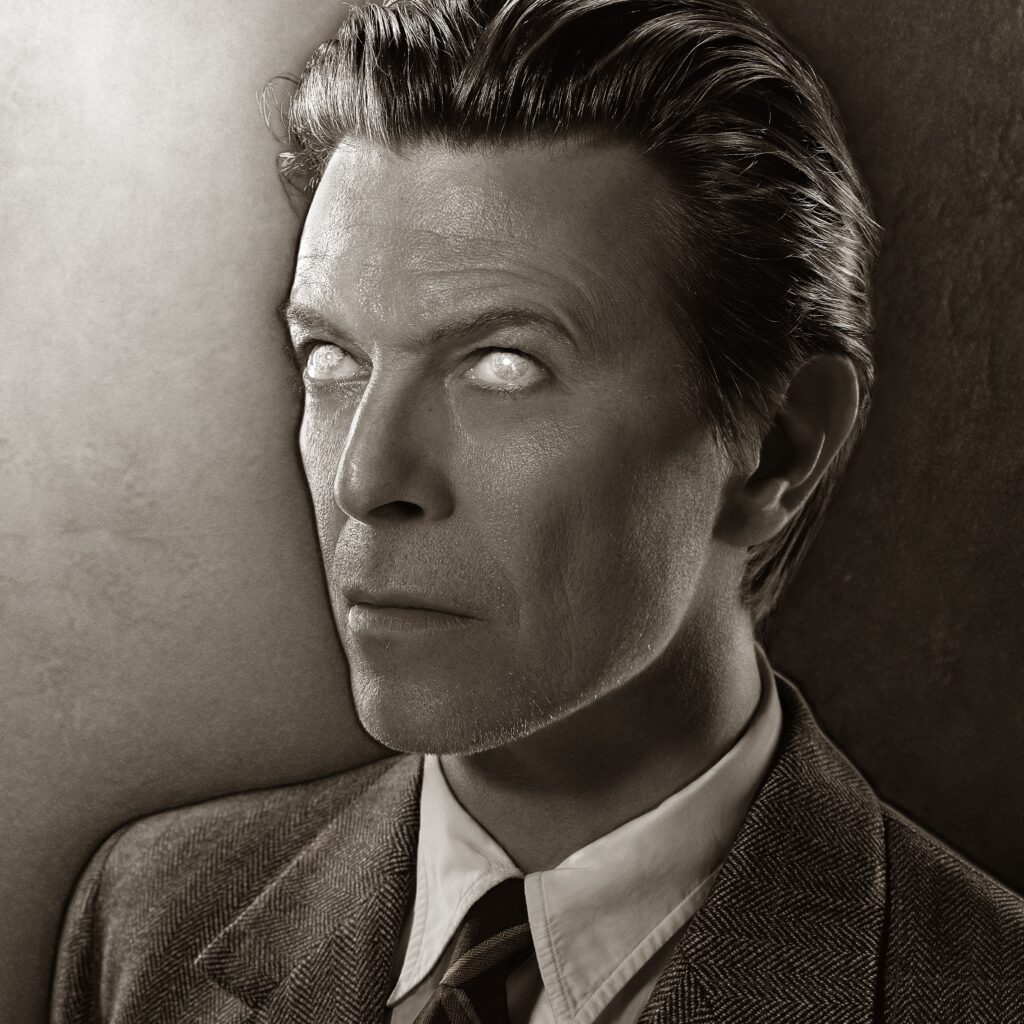
(David Bowie, “Heathen” by Markus Klinko)
VEER: You’ve mentioned David Bowie several times. As a studio recording, “Heathen” is one of my favorites by Bowie, and as album cover art I believe it ranks (in my mind) in the top three of his releases. How did the photoshoot come about for his album cover “Heathen” and what was the concept he was looking for?
MK: Back in the summer of 2001, I was a relatively new photographer on the scene in New York. I was starting to get myself known.
I was doing a lot of editorial magazine photoshoots and on one of those photoshoots I met Angelina Jolie’s makeup artist, who at the time was one of the most famous makeup artists in the world. It was for a photoshoot for Interview magazine, which coincidentally was founded by Andy Warhol, who is my idol.
Right now, I will tell you as an emerging gallery artist, I am most inspired by Andy Warhol.
Going back to the day where I met Paul Starr, the makeup artist, he liked my work and he said he felt I should work with Iman.
He asked me if I had ever met her, and I said no.
He said, “Give me your portfolio.”
At the time, we had these big portfolios. Photographers were always walking around with big portfolios primarily in the commercial world.
So he took my portfolio and he said he was going to show it to Iman, who was a client of his. Within a few hours she called me on the phone and said she loved the work, and that she wanted to come by my studio and setup a photoshoot with me for the cover of her book. She had a coffee table book in the works, for which she had a lot of great photography already by all the greatest names in fashion.
She said she didn’t have a cover and thought I would do a great cover.
She came by my studio, and I was quite thrilled and surprised to see her. We did the photoshoot and were supported by Alexander McQueen, who sent over a lot of dresses.
A couple days later she wanted to come back to choose the photos. I had prepared them on a large line table in my studio.
The doorbell rang, and she said, from downstairs, “I’m here with David. We’re coming up.”
So I open the door and I see David Bowie literally walking up the stairs with her.
He didn’t say much. He was looking through the photos helping her choose, select, and edit. After about ten minutes of that he turned around, looked at me, and said, “If you’re interested, I would like you to shoot my next album cover. I’m working on an album.”
That’s how it all came together.
VEER: Your photograph of Iman that I’m familiar with is the image of her with rings around her neck. Was that the photo she chose?
MK: That’s one of them, yes. The one with the rings around her neck is an African-inspired work that was the actual cover. I like the black and white version a lot that I recently released. But there’s a very colorful, fiery image where she stands on a glass platform where she’s under-lit with an orange light. It looks like she’s on fire. Those are the photos.
VEER: So, David Bowie proposed having you shoot the album cover, and you obviously agreed. What was that collaboration like? How much input did David have and what suggestions did you make as the photographer?
MK: Right after the Iman shoot, 9/11 happened in New York. For a couple months there was really nothing going on in New York, and I didn’t hear anything from anybody.
About five weeks later, Bowie called me on the phone and he was very urgent. He wanted me to come over the next day to his recording studio, which was a couple blocks from my photo studio.
He said he wanted to play the tracks off the new album and wanted to discuss the shoot.
So, I went and he played the entire album for me. His producer Tony Visconti was in the room, and it wasn’t even the final mix, apparently.
He had some references he had picked out of early Man Ray photography.
I said to him, “Well, David, I only shoot color. I don’t do any black and white.”
He said, yeah, he knew that and it was exactly why he wanted me to shoot black and white. He said he thought I would do a great job.
He insisted on doing the photoshoot very, very quickly.
He had a specific reference of the blinded eyes and the angle. He was very specific even with the solarization.
He said once we kinda nailed that, for a setup he was very specific about, he was open to trying other things.
We got done with that (“Heathen” cover shoot) within a couple hours, and then had the whole rest of the day to guide him through a bunch of ideas.
I had a telescope in my studio, by chance, for a prop, and he liked that. I had setup a wooden table and my studio has these brick walls, so it was quite ideal to create this old Hollywood, 1940s, even Humphrey Bogart inspired atmosphere. There was a 1940s suit he really liked.
He contributed a lot by being very spontaneous and going with the flow. It was really a give-and-take between the starting point and then him letting me take him kind of slow to a broad range of ideas.
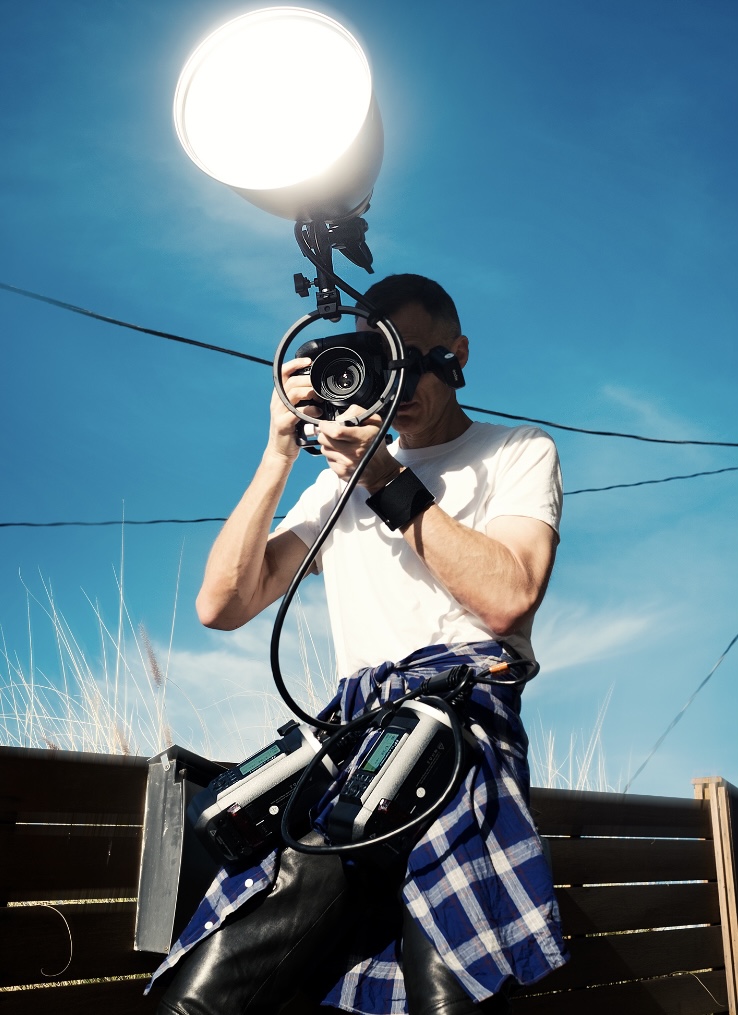
(TALK ABOUT A HEADLAMP: Swiss-born photographer Markus Klinko at work. Photo courtesy of Klinko.)
VEER: There is an image from your shoot of Bowie holding a cigarette. This was somewhat reminiscent of his “Young Americans” album cover. Was he specific about including a cigarette as a prop?
MK: No, I think that is a trademark for him.
If you look at David Bowie’s photographs throughout the past 50 years you’ll see there are numerous photographs of him smoking or holding cigarettes. I just think that’s something he really liked to do.
I didn’t realize this at the time and he didn’t make me aware of that. To be honest, I learned a lot about David Bowie after the fact. I didn’t know as much as you’d expect about David Bowie at the moment of the photoshoot.
I knew a little bit, but I wasn’t a diehard David Bowie fan back in 2001.
VEER: Maybe your photoshoot benefited by you not knowing much about David Bowie.
MK: Yes, I am happy about that.
I have often in my career deliberately, if I didn’t know that much about someone, I didn’t try to necessarily catchup with everything before a shoot. Sometimes out of personal interest later on I would study them more, but many times I didn’t know anything about the artists.
Bowie and Iman were quite advanced in their later careers when I shot them, but Beyonce and Lady Gaga were early-on in their careers when I photographed them.
Now, I know a lot about Gaga. She has become so famous and so much more a broader artist. I’ve watched her films and her music videos. But back in 2009, when I shot her for “Hello Kitty” and it was part of my Bravo TV show that I had at that time, I was preoccupied with just making that photoshoot as hot as possible. I found out later she had been, even in her teens, a performer. I knew one or two songs and thought she was cool, but I got to know her on-set without being too starstruck. I never get starstruck. I’ve been around celebrities a lot. As people, I don’t treat them any differently than anyone else, especially if they don’t act difficult. And most of them don’t.
VEER: How often have you encountered celebrities that have been late to the scheduled photoshoot start time?
MK: Lindsay Lohan, who was humongous at the time when I photographed her, was 17 hours late to one photoshoot, which was actually a photoshoot for her own fashion line that she had hired and paid me for. She showed up a 2 o’clock in the morning instead of 9 am. She had to pay a lot of overtime.
You know, Mariah Carey likes to be fashionably late by 7 or 8 hours. I’d rather have her 7 hours late, looking good and in a great mood than being on-time and cranky. That’s for sure.
But most of them are very punctual. It is what it is.
VEER: There’s a photograph of David Bowie from his glam rock days of the 1970s holding a leash with a large, aggressive dog. Was that the inspiration for your photo of him and the wolf titled “Natural Villains”? Or was this serendipitous? Was it challenging working with a wolf?
MK: I’m now very aware of that Bowie image, which is a famous Bowie image. I did not know it consciously at that time.
The “Heathen” album came out in 2002. Shortly there after, GQ magazine in London called me and said they really loved the album shoot. They asked if I could shoot Bowie again for the cover of their Man of the Year issue later that summer.
I got in touch with Bowie, and he said it is impossible. He said that he was already touring for the album and he simply had no time to do another photoshoot.
So, I then came up with this idea. I told GQ I had enough elements from the initial photoshoot in 2001that I could probably do an intricate photo montage by using a body model, wild animals, and do something really cool.
They loved the idea, so I called Bowie again. I ran this concept by him. He said he’d be thrilled, if it worked. He said I had carte blanche as long as he didn’t have to show up, and he would be excited to see what I could do.
I searched for a body model that had the stature and attitude of Bowie. I also found wolves — three of them as a matter of fact — that came from a farm outside of New York where they were raised by an animal trainer. That person happened to be a Bowie fan and he was happy to bring those wolves to my studio in New York (City), which was not quite legal. You’re not supposed to bring wolves into the City, I think.
I had a whole styling team. I built a fence for myself so as to not have the camera directly in front of the wolf. I was prepared.
With a lot of technical calculations, matching lighting and matching angles, and a very elaborate post-production, I created these wolf images that GQ magazine loved. They disclosed the photo was not real; that this was a photo montage.
Bowie was over the moon, even ecstatic over these photos.
It turned out the photoshoot I did with him in 2001 was actually the last high-production shoots he did. He had done a few shoots at the end of his life, and I directed one of them, but in terms of big, concept productions that was the last.
So that’s the story of the wolves.
VEER: So you elaborately cut and pasted David Bowie’s head and hands onto the body double, who held the wold by a leash?
MK: Simplistically speaking, yes.
It was a little more complex than that. It wasn’t just chopping off the head and glueing it. That wouldn’t look right. It just needed a lot of molding and blending of the elements.
This can look horrible if it’s done badly.
VEER: Well, that was masterfully done by you, Markus.
MK: Well, these photographs are convincing.
Sometimes a Bowie fan on Instagram will think that he’s the only one who knows the secret and will write a trolling comment saying those are not real and those are fake.
I don’t look at it that way. To me, they are a fantasy.
I would say none of my photos are real or fake. They’re all fantasies because they are the result of makeup and hair, lighting and post-production; retouching and all sorts of manipulation before, during, and after the photoshoot.
That’s why I said at the beginning of this conversation, my photos compared to somebody who takes very a spontaneous, almost snapshot approach to photography is very, very different from what I do. It’s not what I’m going for. I can much appreciate it in other people’s work, but for myself I really like to create something that’s manipulated.
Just like a painter. When they paint, they manipulate. They paint it the way they want it to look.
From that perspective, I might have a more painter-y approach to photography. I like to start with a blank canvas and everything you see I put there because I want to and not because it was there already.
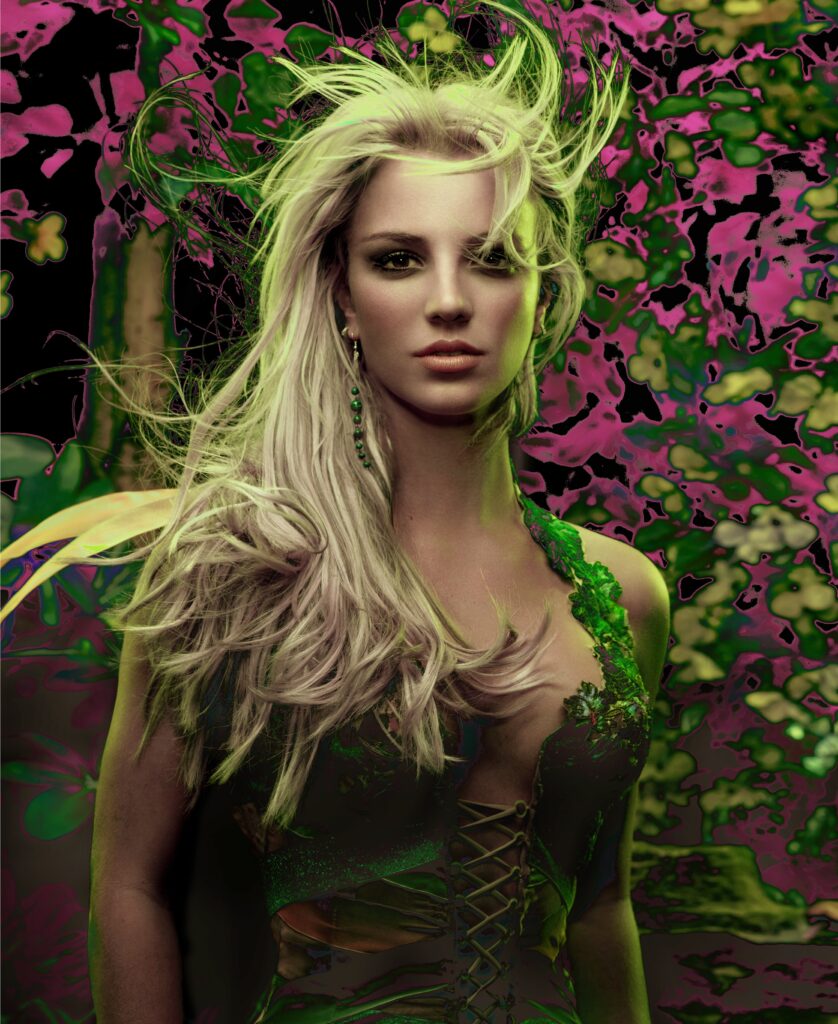
(“Britney Spears, The Forest” by Markus Klinko)
VEER: Speaking of fantasy, the Britney Spears image — with the vibrant colors in the background and lighting — she looks almost like one of the elves in “Lord of the Rings.” Can you talk about that image and what you were going for?
MK: These photos were part of a series she commissioned personally to be illustrations and materials for her upcoming tour at the time called The Onyx Hotel.
She had some ideals, some little drawings she made and keywords she wrote down. They were very much about a fantastical world, a magic forest, the ice princess, the enchanted hotel lobby, and things like that.
I was definitely going for exactly that — a fantasy, almost cartoonish kind of renderings. So not real at all. It was very much like a set for a fantasy movie. That was the idea.
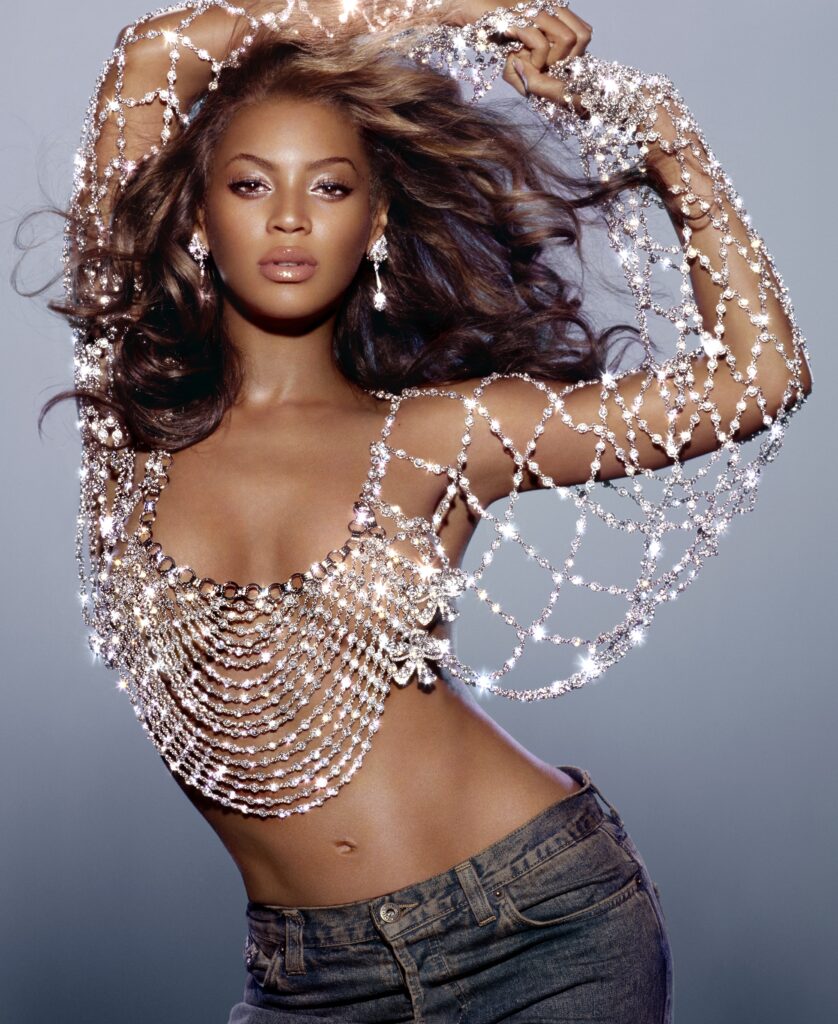
(“Beyonce” by Markus Klinko. This photograph served as her debut album cover.)
VEER: There’s very well-known image of Beyonce where she is wear blue jeans with her upper body wrapped in strings of what looks like diamonds. This photo was for her 2003 debut album cover, “Dangerously in Love.” How did this images come about and can you discuss her body motion as well?
MK: That diamond top was something her mother brought. Her mother was styling her during the early days of Beyonce’s career.
Beyonce didn’t want to wear the top because the intended bottom was this skirt; very red carpet, long flowing.
I said it would look very cool with denim.
She said she didn’t have any.
I suggested she could wear my own jeans that I was wearing. She thought that was a great idea.
It’s funny because I literally went upstairs, changed, and brought her those. She fit them perfectly.
She just started doing those motions as I was photographing her, and putting her arms up in these interesting positions.
It became probably one of the most iconic moments in music photography and music history period because who doesn’t know that image? Generations of people grew up with that as their first album.
It is by far my best known image in terms of recognizability. It’s not necessarily my best selling image at the galleries. That would definitely be Bowie, especially the wolves.
Ironically, the image of Bowie and the wolves are the most manipulated, and yet they appeal to the most people.

